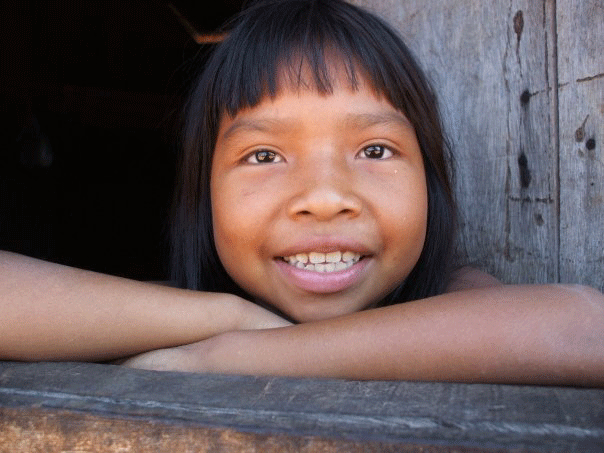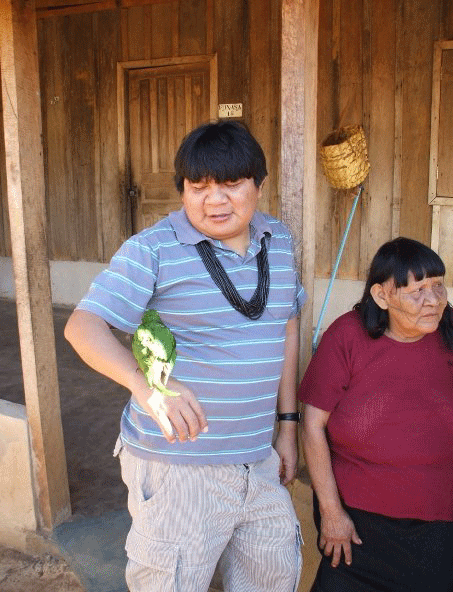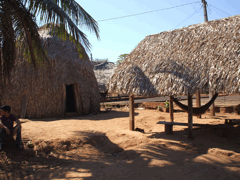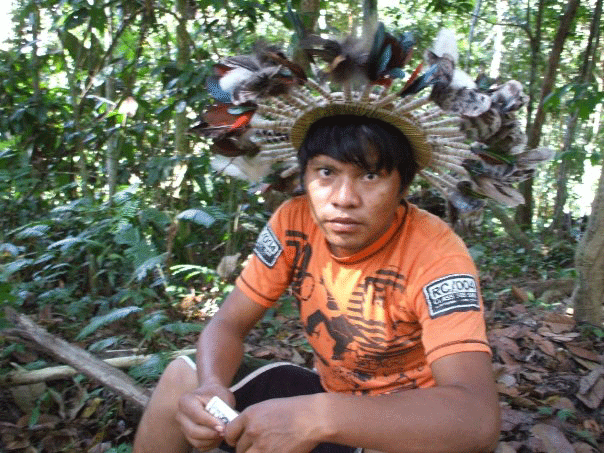Protecting Forests, Sequestering Carbon
Air Date: Week of September 14, 2012

A young Surui girl. (Photo: Bruce Gellerman)
We update a story about an indigenous tribe in the Amazon that’s trying to protect its forest by selling carbon credits on the voluntary carbon market. Living on Earth’s Bobby Bascomb reports.
Transcript
CURWOOD: It’s Living on Earth, I'm Steve Curwood. Around the time of the Copenhagen Climate Summit back in 2009, we aired a number of reports about the UN mechanism which seeks to Reduce Emissions from Deforestation and Degradation - known as REDD.
The idea is to channel payments to countries or communities to enable them to protect their forests and so help limit climate disruption. Among the places we visited was the Brazilian Amazon, where one remote indigenous tribe, the Surui, was pioneering a new forest management plan.
Well, there are some new developments in that story - but before we hear them, here's a reminder of the original report from Living on Earth's Bruce Gellerman, and Bobby Bascomb with their translator, Marco Lima.
[SOUNDS OF UNFOLDING MAP]

Almir Surui points the way forward in the Surui Forest. (Photo: Bobby Bascomb)
BASCOMB: Chief Almir Surui carefully unfolds a map and spreads it on a table. The Surui have been living here in the southwest Amazon for thousands of years, yet this map of their homeland is the first of its kind.
ALMIR: [Translation] If you look individually to every single spot, every single creek. What we did here is simply understand deep inside our wealth. Our people know what we have.
GELLERMAN: On the map are places where the Surui harvest cashews and other foods from the forest. And tiny symbols mark sites where shamans performed rituals and the Surui fought historic battles.
GELLERMAN: What is this, it looks like little huts.
ALMIR: [Translation] Powantigua is the place where there was made the contact with the Surui people.
GELLERMAN: First contact with the Surui was September 7th 1969. That’s the day Brazilian government agents first approached the tribe. Settlers soon followed, stealing 80 percent of the Surui land and bringing new diseases that killed 90 percent of the people.
[MAP UNFOLDING SOUNDS]
BASCOMB: Today, the Surui are fighting back. We’re in the Surui business office in the small town of Cacoal. On a wall hangs a bow and arrow and a long, sharp spear.

Almir Surui holding a parrot next to his mother in the Surui village (Photo: Bobby Bascomb)
[TYPING ON COMPUTER]
BASCOMB: And on a conference table: a laptop. The Surui are now defending their land with computers, GPS units, and satellite images donated by the U.S.-based Amazon Conservation Team. The Surui used the technology to create this detailed map of their reserve.
ALMIR: [Translation] I'm going to show you now how do we want to use technology to protect our territory.
[CLICKING SOUNDS ON COMPUTER]
BASCOMB: So, right now you’re using your laptop to zoom in on – is that your house right there?
ALMIR: [Translation] Here you can see very well how much deforestation we have and also above here you can see the other indigenous territory. All the whites you can see, all the white spots, these are farms that have already destroyed the forest.
BASCOMB: To preserve what’s left of the forest and replant what’s been lost to settlers, Chief Almir has devised a 50-year management plan. It’s a pioneering Indigenous REDD project. The Surui hope to profit by protecting their 600 thousand acre forest and auction off the carbon stored in the trees.
GELLERMAN: They plan to sell the forest carbon as credits to companies and countries that want to offset their climate disrupting emissions. To verify their carbon inventory, the tribe uses images from orbiting satellites. In just two generations, the Surui have gone from the Stone Age to the Space Age.

Except for the telephone pole this could have been a scene of a Surui village 1,000 years ago. (Photo: Bruce Gellerman)
GELLERMAN: You know it’s given you a whole different viewpoint on the world. When you show this to the people of your tribe – when you show these satellite pictures – what do they say?
ALMIR: [Translation] We thought that these images were something like coming from the eye of a monster who likes to eat forest, then we thought, well, maybe we can use the eyes of this monster to protect the forest.
[ROAD SOUNDS]
BASCOMB: It’s 25 bone-jarring miles from Chief Almir ’s office to the Surui tribal village. Our guide, Marco, drives while we bounce around in the back. Almir sits in front.
GELLERMAN: We travel past fields that have been slashed for their hardwood and burned to make way for cattle ranches and soy farms. All that remains of what was once a dense rainforest are knee-high tree stumps, and bitter memories of first contact.

A young man in the Surui rainforest. (Photo: Bruce Gellerman)
ALMIR: [Translation] We had to give up on our land to survive, to remain alive. I’m not against farms; I’m not against production. The only thing I’m really concerned that the white man should see is that they have to grow with sustainable responsibility.
GELLERMAN: When you see this does it make your angry? Does it make you…?
ALMIR: [Translation] I get first of all sad because I really don’t know what happened to a guy like this who simply comes in and clears everything. I don’t know what goes on in his brain.
LIMA: Now we are we getting to the Surui people and as you can see the amazing difference of the vegetation of what you can see over there and what is in here – there you can see the cattle and over there you can see pristine forest.
GELLERMAN: The difference couldn’t be more dramatic: deforestation ends where Surui territory begins. Like a surgeon’s knife, the chain saws of illegal loggers have cut clean, separating dense Surui forest reserve from open farmland.
GELLERMAN: At a sharp bend in the road we see loggers leaning on dirt motorbikes and they see us. We get cold hard stares. I want to stop and talk to the loggers.
BASCOMB: But Almir says, oh, no, no, no. Keep going.
ALMIR: [Translation] Let's not stop. Let’s not stop. They’ll give us a hard time.
GELLERMAN: Why's that?
ALMIR: [Translation] They threat us because all this logging here is illegal. I was threatened so many times here.
BASCOMB: Really?
ALMIR: [Translation] It’s very dangerous.
BASCOMB: Over the past decade 11 tribal elders in the Amazon have been assassinated. Two were Surui. It was almost three: a few years ago someone tried to run Almir off this road. He was evacuated out of Brazil, and when he returned he was promised protection, but Almir says, that was a joke.

Chief Almir’s parents are the last generation with tribal tattoos. The tradition ended after first contact with white settlers in 1969. This photo was taken in 2009. Almir’s father has since passed away. (Photo: Bobby Bascomb)
ALMIR: [Translation] The secret security they were supposed to take care of me it so secret that I’ve never seen it. [Laughs]
[TRUCK STOPS]
GELLERMAN: That’s quite a trip.
BASCOMB: Wasn’t as long as I’d thought it’d be.
GELLERMAN: We finally arrive at the Surui village. It’s a scattering of wood huts with palm-thatched roofs. The Surui sleep in rope hammocks and use wood to cook in open fire pits.
[VILLAGE AMBIENCE]
GELLERMAN: Bon jia…
GELLERMAN: Next to a vegetable garden are solar panels and where coffee beans dry: a satellite dish.
ALMIR: [Translation] Here is our tribe. And here you have my father my mother, my nephews, my brothers.
BASCOMB: The Surui have extended families, and elders are revered. Almir proudly introduces us to his father, the former chief of the tribe.
ALMIR: Marco, Brucy, Bobby.
FATHER: Marco, eh?
ALMIR: Marco.
GELLERMAN: Bruce.
LIMA: Brucee…Bobby.
BASCOMB: Moto Brasie.
LIMA: He says his name is Marimope.
BASCOMB: Chief Marimope’s face is lined with tribal tattoos. His son, Chief Almir has none. The custom ended 40 years ago, after first contact with white settlers. Surui chiefs can have up to four wives. So far, Almir has two. He is the critical link bridging the tribe’s past with it’s future. Chief Almir is the first of the Surui to attend college. Still, tradition and lore guide his way.
[CHOPPING SOUNDS]
GELLERMAN: The forest is sacred to the Surui. It’s essential for their existence and subsistence. The forest provides.
[CHOPPING SOUNDS CONTINUE]
GELLERMAN: A young woman sits on a low wood stool and with quick, sharp blows from her machete, cracks open nuts she’s gathered from the forest, saving the shells and what’s inside.
GELLERMAN: Oh my god, there’s worms. WORMS!
[WOMAN LAUGHS]

The forest provides: a young Surui woman chops nuts. They yield worms to eat and decorative jewelry. (Photo: Bruce Gellerman)
GELLERMAN: Hey, Bobby…take a close look at what she’s doing.
BASCOMB: Oh, those aren’t nuts, those are worms. What are they for? Are those for lunch? Para desauno, para comida?
WOMAN: Comida.
GELLERMAN: And then she’s cutting the shell, watch. She’s cuts the shell. Yeah, she’s cutting the beads, yeah, she’s making beads.
[CHOPPING SOUNDS]
BASCOMB: Ahhh.
[GRASS CRUNCHING; WALKING SOUNDS]
BASCOMB: It’s a short hike to the forest where the Surui gather these nuts. As we walk Chief Almir details his 50-year management plan. The tribe will continue to protect the forest as they’ve always done, and replant 18 thousand acres of trees illegal loggers cut down on Surui territory.
GELLERMAN: All told, the tribe plans to grow a million new trees. So far, they’ve planted 80 thousand.
ALMIR: [Translation] I think what we should do is make this a forest again. Let area receive species that always belonged to here. Feel the air, smell this, so delicious.
[SOUNDS OF BREATHING AIR IN]
ALMIR: Not only through nose, but don’t you feel your skin breathing?
GELLERMAN: Can you restore the forest to the condition that it was before it was destroyed?
ALMIR: [Translation] Yes, we definitely can. That’s why we are researching areas that are today pasture so we can through science understand what kind of species used to live here. And then we can apply to every area according to its needs.
[WALKING NOISES; ALMIR SPEAKING PORTUGUESE]
ALMIR: [Translation] This is a result of re-forestry already. This is also hardwood – mahogano – Brazilian cherry.
BASCOMB: Yeah, how did you choose these trees? Why these trees and not some other kind?
ALMIR: [Translation] The way we thought and planned was let’s replant the trees that suffered the bigger impact. And we also choose fruit trees that can feed our people. And we also picked trees that have big importance on our rituals, things that really make a difference for our culture.
ALMIR: [Translation] Our main idea is to make use of the forest the way it is. Keeping it. Preserving it. Respecting the forest, using the forest the way it, first of all, is going to remain preserved, and then of course in a way it can also benefit not only us, but also the rest of the world.
[BIRD SOUNDS]
GELLERMAN: What is that?
ALMIR: [Translation] “Ah….they are coming,” that’s what they are saying.
CURWOOD: Bruce Gellerman and the Akakai bird - and the Surui believe its calls warn them when they're being watched. Now, nearly four years since we recorded those calls - many people are watching in the Surui's forest. Loggers are still there, and still a threat - but scientists seeking to protect the forest are there too - and their work is close to paying off. Living on Earth's Bobby Bascomb has an update on the latest developments.
BASCOMB: When I first visited the Surui village they were mapping the boundaries of their forest and marking important cultural sites. Today they are busy mapping individual trees using a smart phone. Rebecca Moore, the engineering manager for Google Earth Outreach, is working with the Surui on the project.
MOORE: They they’re using Google Android smart phones that allow the Surui to go out into their forest and do a survey and gather information let’s say about the diameter and species of the trees, the locations of the trees, and that ends up being aggregated and estimating the entire volume of forest that they have for which they are compensated.
BASCOMB: Before smart phones came to the Amazon Surui researchers went out into the forest with GPS units strapped to their back and kept detailed notes in notebooks and on laptop computers. It would take days or weeks to compile all the data. But now….
MOORE: They collect the data and it’s automatically time-stamped, GPS-located, and it goes into their database and the calculations are automatically performed.
BASCOMB: They need to be able to go back to the same trees years later and measure them again to see how much they’ve grown. Then they can calculate how much carbon the trees have absorbed in the process.
MOORE: What they’re gonna do is put barcodes on the trees, and the Google Android smartphone will recognize, oh this is tree 1234, it was this amount of biomass five years ago and this is how much it is now.
BASCOMB: So are you telling me that if I walk through their forest, there’s gonna be barcodes in the trees like in the grocery store?
MOORE: (laughs) I guess, but the size of the barcode relative to the size of these trees in the Amazon—I don’t think you will notice the barcode.
BASCOMB: So far so good. But this is the Amazon, an extremely hostile environment. It’s hot, it rains a lot, and everywhere you turn there are animals.
MOORE: It turns out that there are leaf cutter ants that like plastic and they chew through the plastic barcodes, so there needs to be other experiments with new materials that are more resistant to leaf cutter ants and to apparently the monkeys that like the metal tags.
BASCOMB: Monkeys run off with the shiny metal tags and leaf cutter ants chew up the plastic ones. But in spite of those challenges Chief Almir says they've been able to calculate how much carbon is locked up in their trees – and it’s a lot.
SURUI: We have calculated that the Surui will be avoiding the emissions of about 100,000 tons of carbon into the air every year by protecting our territory and avoiding that it gets deforested.
BASCOMB: 100,000 tons of carbon is roughly equal to the carbon dioxide emitted by 22,000 US cars in a year.
At the moment Almir is reluctant to estimate how much money the carbon credits will generate for his tribe. But Rebecca Moore says the mapping they’ve already done actually makes their trees more valuable.
MOORE: You can charge more for carbon that has social and environmental co-benefits. Under various financial mechanisms, if your forest provides livelihood to indigenous people, if it is a natural ecosystem that houses biodiversity, if it has rivers within it, if there’s certain—it’s called ecosystem services—a natural forest, an intact landscape can provide, you can charge more for the carbon in your trees, and so documenting that with the cultural map actually brings this additional financial benefit to them as well.
BASCOMB: It’s a long complicated process to go from mapping trees to actually getting checks in the mail for protecting them and the carbon they contain. The Surui project was recently validated under the verified carbon standard. That guarantees the carbon credits are legitimate and the environmental benefits are real.
The very first REDD project to get paid is the Kasigau Corridor in Southwest Kenya near the Tanzanian Border. Michael Korchinksy is CEO and founder of Wildlife Works, the NGO organizing that project.
KORCHINSKY: We came to this part of Kenya nearly 16 years ago with the idea of implementing a new conservation model that would be based on innovative market forces rather than the typical charitable model.
BASCOMB: Korchinsky worked with locals to protect 500,000 acres of dryland forest that’s home to a diversity of African wildlife including elephants, lions, and buffalo. The area lies between two national parks and was under increasing pressure from subsistence agriculture.
KORCHINSKY: The conflict in the corridor between people and wildlife was becoming quite intense so thought if we can bring a model that can solve this intense conflict then that model will probably work elsewhere.
BASCOMB: The United Nations, the official organizer of REDD, is still a few years away from developing a formal program to pay countries for protecting their forests so the Kenya project decided to work outside the UN.
KORCHINSKY: For those of us in conservation every year is precious. We loose more forest every year so we decided that we would see if we could jump the gun and get started with the private sector and not wait for the global solution to come from the UN.
BASCOMB: And private companies committed to running carbon-neutral operations are supporting it. The Kasigau Corridor’s largest customers are the South African bank, Nedbank and a European insurance company called Allianze.
The project had to go through 3 rounds of independent audits to certify how much carbon is locked up in the trees and that those trees are actually being protected. But it paid off.
KORCHINSKY: The project is avoiding about 1.2 million tons a year for 30 years. So approximately 35 million tons of emissions over the life of the project.
BASCOMB: The price of carbon on the Voluntary Carbon Market, the only place with a working carbon market, is currently $8 per ton. That means that 1.2 million tons will yield the project more than 9 million dollars a year. One third of that money goes to institutional costs but the remaining two thirds goes directly to the community. 6 million dollars a year can go a long way in Kenya.
KORCHINSKY: One of the things about REDD, in our opinion, is that the scale of finance available through REDD, if REDD continues to be successful it can be transformative for communities.
BASCOMB: In this case the community decided to spend the bulk of their REDD money on education and clean water projects.
KORCHINSKY: We think REDD is a fantastic mechanism to empower forest communities to protect their forest and benefit yet economically. Most forest communities like forest. They live in forest because they like forest and don't want to see their forest destroyed around them. But they need economic power to prevent others from destroying forest around them.
BASCOMB: Empowering forest communities through REDD is a growing trend around the world from Panama, to Cambodia to the Democratic Republic of Congo.
The Surui project in the Amazon is the first indigenous REDD project in the world. It’s also the first REDD project of any kind in Brazil, and only the second in the world to get validated. Chief Almir Surui says that the health of his community and the health of the forest are one and the same.
SURUI (Through Translator): My family we cannot live without the forest as much as we cannot live without our culture. We need the forest and our culture to survive and live. What we want to achieve by developing a green economy, developing a sustainable way of life, is guaranteeing the future, guaranteeing the future of the next generations.
BASCOMB: Within a few months the Surui expect to wrap up the REDD certification process and start getting paid for protecting the forest they’ve lived in for millennia. And Surui leaders hope REDD will help guarantee a healthy forest for future generations of the tribe. For Living on Earth I’m Bobby Bascomb.
[MUSIC: Apollo Nove “Fruta Vermelha” from Res Inexplicata Volans (Crammed Discs 2005).]
CURWOOD: Our update from Brazil was made possible by a fellowship from Earth
Journalism Network. You can find pictures of the Surui village over at our website loe.org.
Links
Listen to the Full Story about the Surui
Listen to the Full Hour Long Documentary about REDD in Brazil
Living on Earth wants to hear from you!
Living on Earth
62 Calef Highway, Suite 212
Lee, NH 03861
Telephone: 617-287-4121
E-mail: comments@loe.org
Newsletter [Click here]
Donate to Living on Earth!
Living on Earth is an independent media program and relies entirely on contributions from listeners and institutions supporting public service. Please donate now to preserve an independent environmental voice.
NewsletterLiving on Earth offers a weekly delivery of the show's rundown to your mailbox. Sign up for our newsletter today!
 Sailors For The Sea: Be the change you want to sea.
Sailors For The Sea: Be the change you want to sea.
 The Grantham Foundation for the Protection of the Environment: Committed to protecting and improving the health of the global environment.
The Grantham Foundation for the Protection of the Environment: Committed to protecting and improving the health of the global environment.
 Contribute to Living on Earth and receive, as our gift to you, an archival print of one of Mark Seth Lender's extraordinary wildlife photographs. Follow the link to see Mark's current collection of photographs.
Contribute to Living on Earth and receive, as our gift to you, an archival print of one of Mark Seth Lender's extraordinary wildlife photographs. Follow the link to see Mark's current collection of photographs.
 Buy a signed copy of Mark Seth Lender's book Smeagull the Seagull & support Living on Earth
Buy a signed copy of Mark Seth Lender's book Smeagull the Seagull & support Living on Earth

